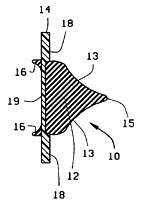
Issue: 2/02
Sealing sanitary and storm sewer piping is typically more difficult than sealing interior plumbing, mostly because of their construction, and typically because of their size. This is especially true in main lines. In a typical sewer main, the pipe ends are spigot-and-bell construction, and sealing is commonly achieved with some type of o-ring. There are numerous inherent problems with assembling these connections.
Initially, there is the problem that pipe ends may not have been designed and manufactured with grooves to receive the sealing o-ring. Then there is the situation that when there is a groove, it may not necessarily be the desired depth, or even if it is that it just requires more material in the seal to fill that groove. In all instances, there is the common danger of rolling the seal out of position or shearing part of it completely away; leaks can and do result.
Inventor Thomas P. Kearns of Bonne Terre, MO, has developed a new sewer sealing gasket that addresses these problems and looks like it may be ample to the job of solving them. On May 29, 2001, Kearns received U.S. Patent no. 6,237,966 for new efforts titled "Co-Extruded Dual Durometer Hardness Pipe Gasket," which is now assigned to Bidco Plastic Extrusion, Inc. in Park Hills, MO.
The gasket consists of two portions. The tongue (item 12 in Figure 1) is made of a relatively soft material, such as an extrudable thermoplastic elastomer. The second portion or substrate (item 14 in Figure 1) is made of a relatively harder material, such as polypropylene plastic. Both the first and second materials are sufficiently flexible so that after being co-extruded and cut into the desired length, they can be bent to the desired radius and the ends welded to form an annular gasket.
The tongue portion of the gasket is made from a black, thermoplastic, commercial-grade elastomer that is a mixture of EPDM (Ethylene Propylene Diene Monomer) and polypropylene (and thus, compatible with a polypropylene substrate) having a hardness of 45 Shore A. Now this may sound like more technical information than is really necessary, but it is important to realize that the choice of this specific blend of materials was designed to ensure it would meet ASTM standard F-477 for elastomeric seals (gasket) for joining plastic pipe.
In applications where the available pipe in fact does have a receiving groove, Kearns' gasket utilizes the substrate section to span the groove. The two ridges on the underside of the substrate (item 16 in Figure 1) hold the gasket in position from slippage. The advantage is that this requires less gasket material, and should provide for less expensive gaskets in the assembly. Considering the large number of connections in this type of system, even a comparatively small savings could ultimately add up to a significant cost reduction.
In applications where no groove in the pipe spigot or bell is provided, the same gasket is applicable. In this case, because the underside of the substrate is, with the exception of the two small ridges, relatively flat, the gasket will sit on the outer surface of the spigot (male) end of the pipe. While this distinction may seem relatively slight, here again we see potential cost savings due to not having to stock different types of gasket profiles to accommodate different projects or differences with a single project. It is interesting to note that under the auspices of the patent, the ridges on the underside of the substrate can be either molded from the same relatively soft material as the tongue to accommodate compression, or directly as part of the relatively harder substrate, which would simplify manufacturing of the gasket cross-section.
In general, the design intent for the substrate is to be 0.030" thick in a typical application, or slightly less than 1/32 of an inch. With this thickness and a substrate of polypropylene, gasket diameters of 12.5" can readily be formed. Gaskets having larger diameters (e.g., 30-36") can, if desired, be co-extruded with heavier, thicker substrates than those prepared for smaller diameter gaskets.
Although the gasket has been described as being configured for initially seating on the spigot pipe, it is to be understood that the gasket may be configured for initial seating in the bell pipe without departing from the spirit of this invention. With a little imagination, it should also be apparent that it would be just as possible to invert the gasket to fit in a groove in the bell-end of the pipe with the tongue facing inward to interface with the outer face of the spigot end.